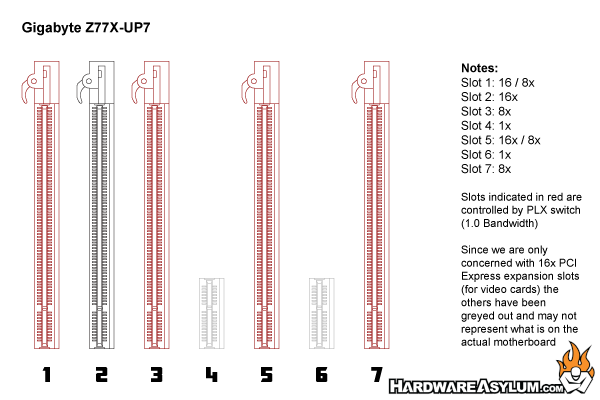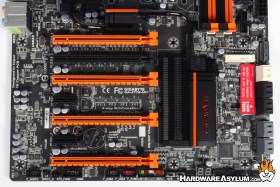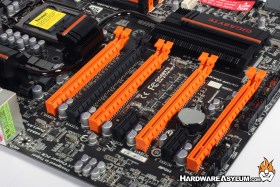Gigabyte Z77X UP7 Overclocking Motherboard Review
Author: Dennis Garcia
Published: Monday, November 12, 2012
Multi GPU Index
The Ninjalane Multi-GPU index is a portable set of data we can use to determine the multi-gpu potential of any motherboard. A higher index number indicates a favorable condition for multiple graphics cards while a lower number indicates a hindrance in one of our leading indicators. Since the Index is not dependent on system architecture it can be applied to any motherboard regardless of processor or chipset generations.
Multi-GPU Scorecard
Index: 4.75
Optimized: 4x
Max Support: 4x
Optimized: 4x
Max Support: 4x
Technologies Supported
NVidia SLI
AMD Crossfire
Lucid Virtu
AMD Crossfire
Lucid Virtu

As indicated by the PCI Express layout chart there are a total of five 16x PCI Express slots on this motherboard with all five using bandwidth earmarked for video cards. The configuration is rather unique because you are given a choice of bandwidth allocations depending on your system configuration.
One of the biggest complaints overclockers have is the latency induced from a PCI Express switch chip however to run more than two graphics cards on the Z77 you need something like the PLX 8747 switch to redistribute the lane allocation. To give overclockers the best of both worlds Gigabyte has given you a choice between the two.
Slot two is your primary video card slot and will run at a full 16x direct from the CPU when only a single card is installed. Slots one, three, five, and seven are all powered by the onboard PLX PEX 8747 5-port 48-lane PCI Express switch. The primary graphic slots will be one and five which in turn share bandwidth with their nearest downstairs neighbor.
For best video performance you will want to populate slots one and three with video cards. For proper quad card configurations, using either NVidia SLI or AMD Crossfire, you'll populate slots one, three, five and seven.
One of the biggest complaints overclockers have is the latency induced from a PCI Express switch chip however to run more than two graphics cards on the Z77 you need something like the PLX 8747 switch to redistribute the lane allocation. To give overclockers the best of both worlds Gigabyte has given you a choice between the two.
Slot two is your primary video card slot and will run at a full 16x direct from the CPU when only a single card is installed. Slots one, three, five, and seven are all powered by the onboard PLX PEX 8747 5-port 48-lane PCI Express switch. The primary graphic slots will be one and five which in turn share bandwidth with their nearest downstairs neighbor.
For best video performance you will want to populate slots one and three with video cards. For proper quad card configurations, using either NVidia SLI or AMD Crossfire, you'll populate slots one, three, five and seven.



